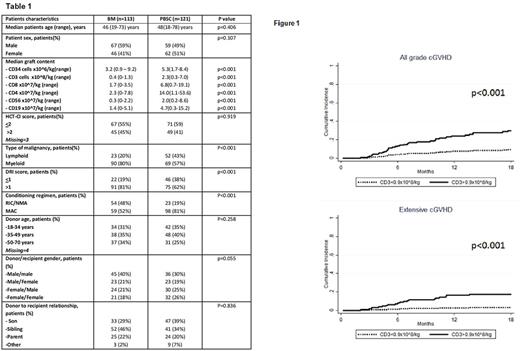Abstract
Background: Haploidentical hematopoietic cell transplantation (HCT) using post-transplant cyclophosphamide (PT-Cy) as graft-versus-host disease (GVHD) prophylaxis has shown promising results. A possible influence on outcome according to graft type [peripheral blood stem cells (PBSC) vs bone marrow (BM), Asad Bashey JCO 2017 ] has been recently shown, however there are still no data regarding graft composition and donor type influence on survival outcomes. We conducted a retrospective study on haploidentical HCT using PT-Cy according to graft source, donor characteristics and graft cell composition.
Methods: 234 (>18 years old) patients who underwent HCT between 2010 and 2016 from 5 European hospitals were included. Patients, disease and transplant characteristics were collected from centers' registries and medical records. Donor characteristics (age, type, gender) and graft cell composition (CD34+, CD3+, CD4+, CD8+, CD56+, CD19+) data were also analyzed. Graft cell counts were considered as continuous variables. The primary end-point was overall survival (OS). Secondary endpoints included cumulative incidence of acute and chronic GVHD, non-relapse mortality (NRM), relapse/progression (RI/PD), progression-free survival (PFS) and GVHD and Relapse-Free Survival (GRFS). Median follow up for surviving patients was 18 months. Only variables significant in univariate analysis were included in the multivariate models with the graft cell counts.
Results: Study cohort characteristics are shown in Table 1. Day +30 and +90 neutrophil and platelet recovery were 92%, 95% and 61% and 81% respectively with no differences between PBSC and BM. Acute GVHD grade II-IV incidence at day +100 was 34% (BM 26% vs PBSC 41%, p=0.002) while grade III-IV was 11% (BM 6% vs 17%, p=0.003). Chronic GVHD incidence at 18 months was 19% (BM 6% vs PBSC 33%, p<0.001) and extensive chronic GVHD incidence was 10% (BM 1% vs PBSC 20%, p<0.001). At 18 months, OS, PFS and GRFS were 46%, 60% and 36% respectively. Cumulative incidence of NRM and RI/PD were 15% and 35% with no differences between BM and PBSC.
On multivariate analysis, OS was favorably affected by CR at transplant (HR 0.47, p=0.002) and negatively by age>50yrs (HR 1.95, p=0.012), Comorbidity Score >2 (HR 1.83, p=0.004), and higher CD8+ graft cell content (HR 1.15, p=0.034). PFS was positively affected by CR at transplant (HR 0.53, p=0.002) and negatively by Disease Risk Index > Intermediate-High (HR 1.66, p=0.030) and Comorbidity Score >2 (HR 1.45, p=0.046). Similarly, GRFS was positively influenced by CR at transplant (HR 0.60, p=0.006) and negatively by Comorbidity Score >2 (HR 1.45, p=0.032). As expected RI/PD was negatively affected by Disease Risk Index > Intermediate-High (HR 1.91, p=0.030), but CR at transplant (HR 0.59, p=0.033) and higher CD4 graft cell count showed a protective effect (HR 0.83, p=0.007). NRM was favorably influenced only by higher CD3 graft cell count (HR 0.08, p=<0.001) while age>50yrs (HR 1.98, p=0.033), Comorbidity Score >2 (HR 1.97, p=0.049), higher CD8 graft count (HR 1.13, p=0.005) and higher CD4 graft count (HR 1.34, p=0.010) had a detrimental effect. Interestingly, when analyzing GVHD incidence in the multivariate model, we observed that graft cell composition variables abrogated the graft source effect (PBSC vs BM). In particular, no prognostic factors influenced acute GVHD grade II-IV while all grade and extensive chronic GVHD incidence were strongly increased when a higher CD3 graft cell composition was used (HR 3.49, p=0.008 for all grade chronic GVHD and HR 5.54, p=0.017 for extensive chronic GVHD). A cut off value of 0.9 x 10^8/kg CD3 graft cell count was able to effectively split both all grade chronic GVHD (33% vs 6%, p<0.001) and extensive chronic GVHD (19% vs 2%, p<0.001) curves (Figure 1). Donor characteristics did not influence any outcomes.
Conclusion: PT-Cy mediated T cell repletion abrogates the effects of donor characteristics on survival outcomes as opposed to ATG-based haploidentical platform (Yu Wang, Blood 2014). The higher incidence of chronic GVHD is probably explained by a higher number of graft CD3+ cells (>0.9 x 10^8/kg) and not merely by graft type (BM vs PBSC). These results could help in adapting GVHD prophylaxis for those high risk patients who infused high CD3 content grafts. These observations should be validated on prospective multicentric studies.
Ciceri: GSK: Other: B-thalassemia gene therapy was developed by Fondazione Telethon and Ospedale San Raffaele and has been inlicenced by GSK that provides funding for the clinical trial, Research Funding. Corradini: Gilead: Honoraria; Takeda: Honoraria; Amgen: Honoraria; Celgene: Honoraria; Janssen: Honoraria; Roche: Honoraria; Sanofi: Honoraria; Novartis: Honoraria.
Author notes
Asterisk with author names denotes non-ASH members.


This feature is available to Subscribers Only
Sign In or Create an Account Close Modal